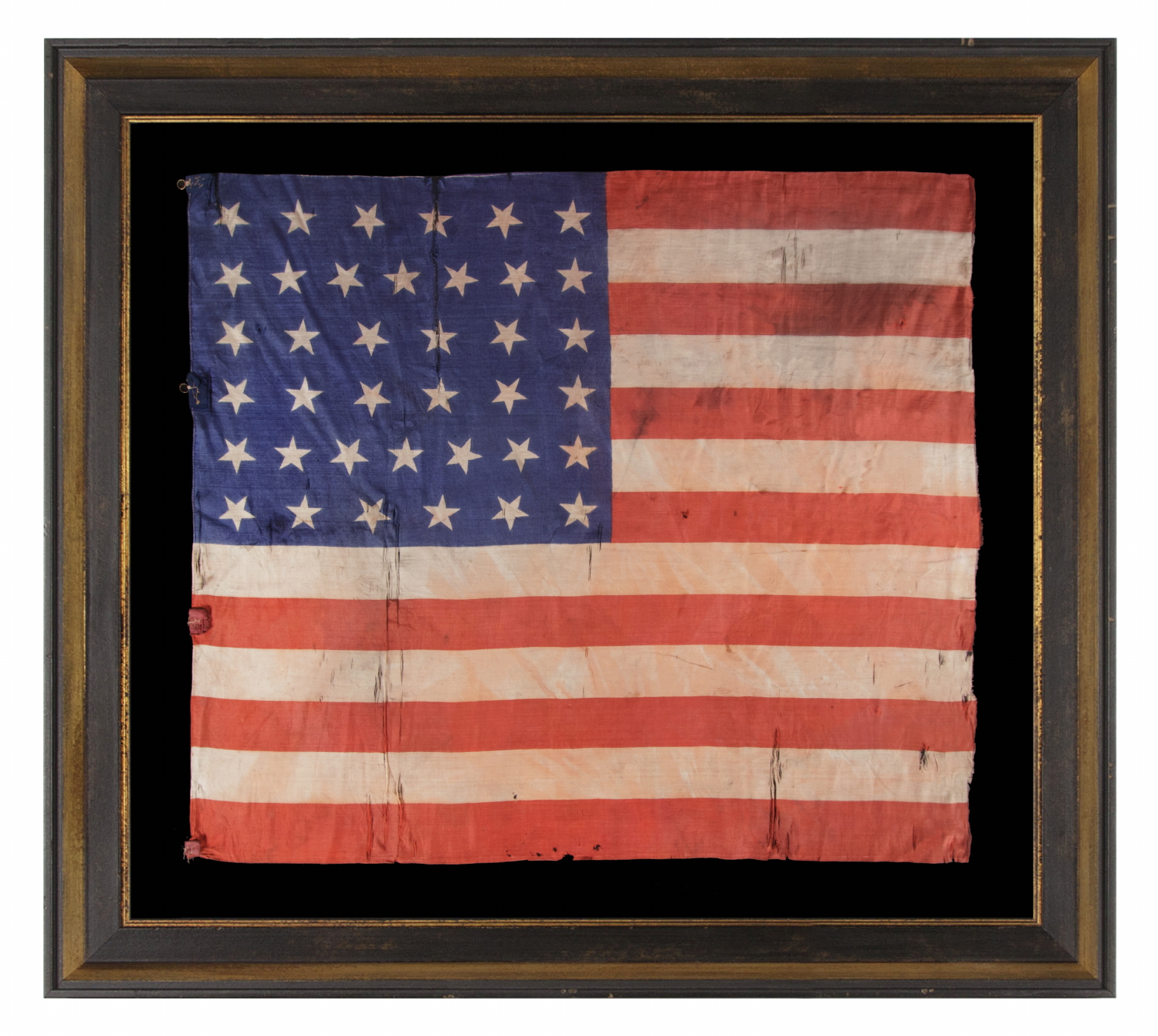
| |
38 STARS WITH SCATTERED ORIENTATION, ON A SILK ANTIQUE AMERICAN PARADE FLAG WITH GENEROUS SCALE AND ENDEARING WEAR FROM OBVIOUS USE, COLORADO STATEHOOD, 1876-1889 |
|
| Available: |
Sold |
| Frame Size (H x L): |
Approx. 43" x 47.5" |
| Flag Size (H x L): |
30.5" x 35" |
|
| Description....: |
|
38 star American national parade flag, printed on silk. The stars are arranged in justified, linear rows of 6-7-6-6-7-6. Flags that have star counts that vary by row, but which have rows that are justified in length, often develop secondary patterns. I refer to this particular style as the "Double-D," due to the two D-shaped formations of stars that face one another, in mirror image, in the canton. Other configurations can also be viewed, such as the standing ellipse of 6 stars in the center of the pattern, or the two stacked hexagons in the middle, each of which has a star in the center, and which together form a sort of vertical pillar. This is a very scarce parade flag variety that I have seldom encountered. Note how the stars are oriented in various positions on their vertical axis, which adds a strong element of folk quality to the design.
The hoist end was bound with treadle stitching and a series of four brass rings were placed at intervals along this, each hand-stitched on top of applied silk tabs. Two of the rings are now absent.
Colorado became the 38th state on August 1st, 1876. This was the year of our nation’s 100-year anniversary of independence. Per the Third Flag Act of 1818, stars were not officially added until the 4th of July following a state's addition. For this reason, 37 was the official star count for the American flag in 1876. Flag-making was a competitive venture, however, and few flag-makers would have been continuing to produce 37 star flags when their competitors were making 38’s. It is for this reason that 38 and 13 stars (to represent the original 13 colonies) are more often seen at the Centennial International Exposition, the six-month long World’s Fair held in Philadelphia in honor of the event. Some flag-makers would have been adding a star for the 38th state even before it entered the Union, in the early part of 1876 or even prior. In fact, many makers of parade flags were actually producing 39 star flags, in hopeful anticipation of the addition of two more Western Territories instead of one. But the 39th state would not join the Union for another 13 years, when the Dakota Territory entered as two states on the same day. The 38 star flag became official on July 4th, 1877 and was generally used until the addition of the Dakotas in 1889.
The flag was obviously flown for an extended period and displays all of the relevant attributes thereof. There are significant vertical splits in tree locations, including one near the top center of the canton that carries down into the 4th row of stars, and another, below, that extends upward in two lines from the bottom of the flag into the last row of stars, and one further out, towards the fly end, which runs upward from the bottom into the 3rd to last stripe. There are various smaller splits in other areas, some of which, like the larger ones, exhibit associated loss, and there are a number of minor holes and nicks. There is some bleeding of the red dye into the white stripes, much of which is oriented at a slant and actually lends some movement to the presentation. There are also various stains throughout, the largest of which are located in the 2nd through the 4th stripes.
The length of the flag was tore away over the course of time from obvious use. Based upon another example that I previously owned, the overall original length would have been approx. 42 inches. The resulting, square format makes it appear like silk, infantry battle flags of the period, which measured 6 x 6.5 feet, officially, and were thus very similar in profile. The shape is also interesting to the eye, because it is different than what the average person would expect in a modern flag. Prior to 1912, there was neither an official star pattern or official proportions for the American national flag, so much was left open to interpretation, creativity, and the most practical use of the object.
Mounting: The flag was mounted and framed within our own conservation department, which is led by expert trained staff. We take great care in the mounting and preservation of flags and have framed thousands of examples.
The background is 100% cotton twill, black in color, which has been washed and treated to reduce and set the dye. The black-painted, hand-gilded and distressed molding is Italian. The glazing is U.V. protective plexiglass. Feel free to contact us for more details.
Condition: See the last paragraph of the description for a relevant narrative. Many of my clients prefer early flags to show their age and history of use. |
|
|
|
| Collector Level: |
Intermediate-Level Collectors and Special Gifts |
|
| Flag Type: |
Parade flag |
|
| Star Count: |
38 |
|
| Earliest Date of Origin: |
1876 |
|
| Latest Date of Origin: |
1889 |
|
| State/Affiliation: |
Colorado |
|
| War Association: |
1866-1890 Indian Wars |
|
| Price: |
SOLD |
|
| |
Views: 460 |
|
|
|

